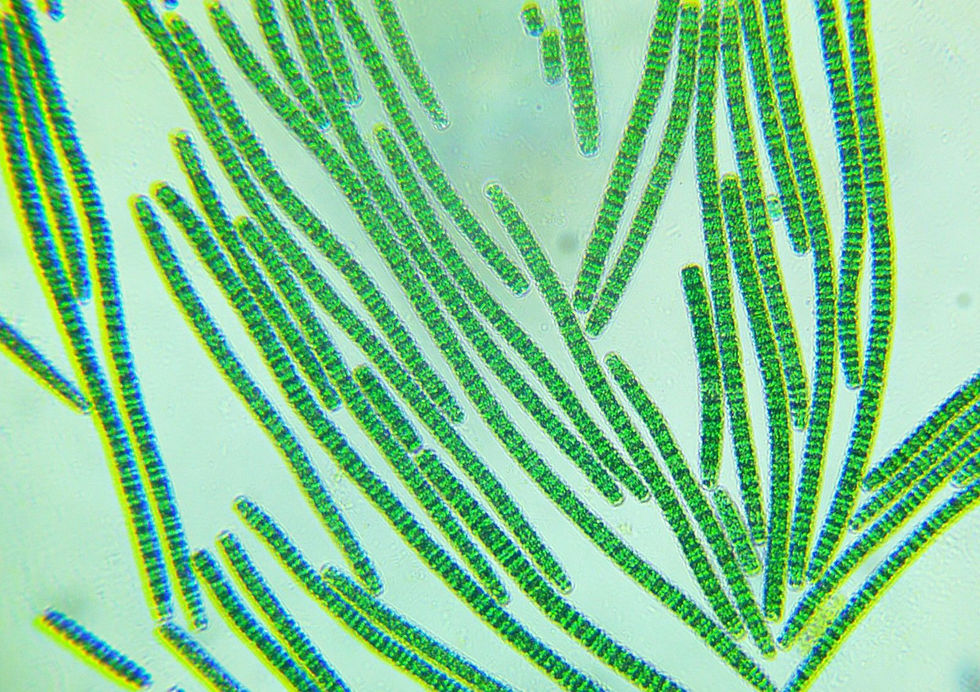Unveiling Spirulina: Health, Business, and Beyond
- DHRUVI GOHIL
- Dec 1, 2024
- 4 min read
Spirulina is a type of cyanobacteria, often mistaken for algae due to its vibrant green color and aquatic habitat. Unlike plants, spirulina is a photosynthetic microorganism, converting sunlight into energy through pigments like chlorophyll and phycocyanin. It thrives in warm, alkaline environments, such as lakes and controlled aquaculture systems. Spirulina thrives in warm, alkaline environments with temperatures between 25°C to 35°C and a pH range of 9 to 11. It requires clean water, adequate sunlight or artificial light, and a steady supply of carbon dioxide for photosynthesis. Essential nutrients like nitrogen, iron, and potassium support its growth, making it ideal for controlled aquaculture systems or indoor farms.
Historically, spirulina was first harvested by the Aztecs in Mexico from the waters of Lake Texcoco. They dried it into cakes called tecuitlatl, which provided a sustainable and nutrient-rich food source. Similarly, communities near Lake Chad in Africa have traditionally relied on spirulina, harvested from the lake’s alkaline waters, as a key component of their diet. Today, spirulina is cultivated worldwide, particularly in regions with optimal sunlight and warm temperatures, such as India, the USA, and parts of Southeast Asia.
Spirulina’s biological structure and functionality are fascinating. It is spiral-shaped, giving it its name, and visible only under a microscope. As a cyanobacterium, spirulina performs photosynthesis, using sunlight to convert carbon dioxide and water into glucose and oxygen. This process is facilitated by its pigments: chlorophyll, which gives it a green color, and phycocyanin, responsible for its striking blue hue. One of spirulina’s unique features is its ability to thrive in high-pH, low-salinity environments where few other organisms can survive. This resilience not only makes it easy to cultivate but also ensures its purity, as fewer contaminants can coexist in such conditions.
Spirulina’s versatility extends far beyond its role as a dietary supplement. In the world of nutrition, it is most commonly consumed in powder or tablet form, often added to smoothies, energy bars, or snacks for its high protein and nutrient content. Additionally, spirulina plays a growing role in animal feed, particularly in aquaculture and poultry farming, where it enhances the health and growth of fish, shrimp, and chickens. In the beauty industry, spirulina’s antioxidants and vitamins make it a popular ingredient in skincare products, known for its anti-aging and skin-rejuvenating properties. Furthermore, spirulina is being utilized in sustainability initiatives to address global malnutrition. Its high nutrient density and ease of cultivation make it a cost-effective solution in regions where access to fresh produce and protein is limited.
Photo credit-zenement.com
NASA has investigated spirulina as part of life support systems for astronauts, as it can be cultivated in a controlled environment and provides a high-density source of protein, vitamins, and minerals. In the microgravity environment of space, spirulina’s ability to grow quickly with minimal resources requiring only light, water, and carbon dioxide makes it a sustainable food source for astronauts. It could potentially help reduce the need for traditional food storage, as spirulina could be grown on spacecraft or space stations, providing a fresh, nutritious supplement to astronauts’ diets while also contributing to oxygen production and carbon dioxide absorption. Spirulina's inclusion in space missions not only supports astronaut health but also advances the research in creating closed-loop ecological systems, where food can be grown and recycled in space.
Photo credit-www.biolyn.com
Spirulina is often lauded as one of the most nutrient-dense foods on Earth. Its protein content, which can reach up to 70% by weight, makes it a highly efficient plant-based protein source. Moreover, it is a complete protein, containing all nine essential amino acids required by the human body. This makes it particularly valuable for vegetarians, vegans, and individuals seeking alternative protein sources. Beyond protein, spirulina is a treasure trove of vitamins and minerals. It is rich in B vitamins (B1, B2, and B3), iron, magnesium, potassium, and calcium, all of which are crucial for maintaining overall health. Its antioxidant profile, particularly the presence of phycocyanin, helps combat oxidative stress and reduce inflammation in the body. Spirulina is also known to support heart health by lowering LDL (bad cholesterol) levels, while simultaneously boosting HDL (good cholesterol). Additionally, its natural detoxifying properties allow it to bind to heavy metals in the body, promoting liver and kidney health.
Spirulina’s global demand has surged in recent years, driven by the increasing awareness of health, sustainability, and environmental issues. The spirulina market is projected to grow at an annual rate of over 10%, with key players including the USA, India, and China leading production efforts. Controlled cultivation environments, such as spirulina farms, have been developed to meet this demand, ensuring consistent quality and purity. The business opportunities surrounding spirulina are diverse. In addition to health supplements, spirulina is gaining popularity in cosmetics, animal feed, and even experimental fields like biofuel production and biodegradable packaging. Social enterprises and non-profits are also leveraging spirulina to combat malnutrition, distributing it as an affordable, nutrient-rich food to vulnerable populations in developing countries.
Photo credit-krishijagran.com
Spirulina stands as a remarkable superfood, offering unparalleled nutritional benefits and sustainable solutions for the future. From improving health to supporting space missions, its potential spans far beyond the plate, shaping a more resilient and sustainable world.











Comments